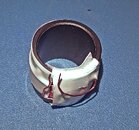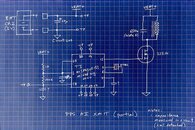I have been looking around and it looks like there is absolutely no project even attempting to do RF transmission at 38 kHz or even LF.
The transmitter and receiver circuits for this are not really radio. Radio transmits and receives the ELECTRIC field of the electromagnetic (EM) radiation using (usually wire) antennas. These scuba tank pressure reporting systems (and RFID tags, wireless charging, NFC on smartphones, tap-to-pay credit cards) transmit and receive the MAGNETIC field of the EM radiation using induction coils. The transmitting coil and the receiving coil make an air-gap (or water-gap) transformer. A varying electric current passing through the primary coil creates a magnetic field which propagates through the air (or water) to the other coil, where it induces a (weak) current in the secondary coil that varies just like the original. This is exactly what goes on inside a lot of audio amplifiers, so look for audio amplifier circuits that use an impedence matching transformer at the output before the speaker.
Here's an example from circuitstoday.com of a basic idea for the transmitter. I've crudely indicated what to remove, and added a capacitor across the coil to make a resonant circuit that would need to be tuned to 38 kHz. The "audio in" would just be a constant 38 kHz generated by the microcontroller and switched on and off to get the right timing between bursts. Of course this isn't a useable circuit - just shows the basic concept: amplify input pulse train, with output to a resonant LC ("tank") circuit. Looking for audio circuits and resonant circuits (of which there are scads) gets you closer than looking at RF.

So imagine removing the speaker and the output (secondary) coil of the transformer from the amplifier. The remaining coil will still radiate the magnetic field. If the other coil is set up across the room with its own amplifier and speaker, it can receive a (faint) copy of the magnetic field, amplify the signal, and send it to the speaker. We now have a magnetic induction transmitter and receiver pair for sending audio across the room.
[Edit: the above is a major simplification, but I realize now it's a also misleading when thinking about the receiver. Sorry. The incoming signal is a series of bursts of 38 kHz (about 10 cycles each burst I think), separated by either a long or short pause (encoding "1" or "0"). The reciever needs to recover the on-off of these bursts from the 38 kHz signal, which requires an AM style detector circuit. Searching online for "TRF receiver circuit" will get you lots of examples of the simplest (and oldest) design. TRF is "tuned radio frequency".
38 kHz sound is beyond human hearing, that is, ultrasonic. But it's in the same ballpark. So for our transmitter and receiver the electronics can be fundamentally the same kind of design; it just needs to be tweaked for this frequency, and can be simplified because it only has to handle one narrow band of frequencies aound 38 kHz. In fact many of the same components (transistors, op-amps) still work fine at that frequency. Of course the devil is in the details, so that's as far as I can take it without doing some serious relearning, but hopefully this makes some sense for those without much electronics background.





